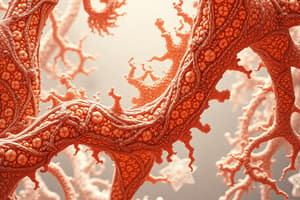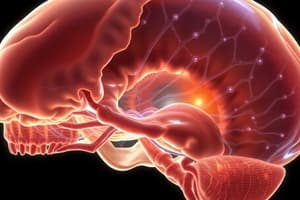Podcast
Questions and Answers
During craniofacial development, which of the following structures is LEAST likely to be derived from the lateral plate mesoderm?
During craniofacial development, which of the following structures is LEAST likely to be derived from the lateral plate mesoderm?
- Connective tissue within the laryngeal region.
- The arytenoid cartilage contributing to the formation of the larynx.
- The cricoid cartilage forming a part of the larynx.
- The dermis of the dorsal region of the head. (correct)
If neural crest cell migration to the pharyngeal arches is selectively inhibited during early embryogenesis, which of the following developmental defects would be MOST likely to occur?
If neural crest cell migration to the pharyngeal arches is selectively inhibited during early embryogenesis, which of the following developmental defects would be MOST likely to occur?
- Complete absence of the voluntary muscles of facial expression e.g. the buccinator and orbicularis oris.
- Severe malformation of the facial bones and structures including the maxilla and mandible. (correct)
- Agenesis, or severe hypoplasia, of the arytenoid and cricoid cartilages.
- Failure of the 5th, 7th, 9th and 10th cranial sensory ganglia to form.
A researcher is investigating the molecular signals that direct differentiation of cranial neural crest cells (CNCCs) into specific cell types. If the researcher selectively ablates a transcription factor crucial for osteoblast differentiation within the CNCCs, which of the following outcomes is MOST probable?
A researcher is investigating the molecular signals that direct differentiation of cranial neural crest cells (CNCCs) into specific cell types. If the researcher selectively ablates a transcription factor crucial for osteoblast differentiation within the CNCCs, which of the following outcomes is MOST probable?
- Enhanced chondrogenesis, leading to compensatory overgrowth of cartilage in the neurocranium.
- Complete absence of the pia and arachnoid layers of the meninges.
- Disrupted development of the dentin in the teeth.
- Impaired formation of facial bones, potentially resulting in craniofacial dysostosis phenotypes. (correct)
In a mouse model, a targeted mutation disrupts the proper migration of ectodermal placode-derived cells during cranial nerve ganglia formation. Which of the following cranial nerve deficits would MOST likely be observed in the affected mice?
In a mouse model, a targeted mutation disrupts the proper migration of ectodermal placode-derived cells during cranial nerve ganglia formation. Which of the following cranial nerve deficits would MOST likely be observed in the affected mice?
A researcher performs an experiment involving the selective ablation of paraxial mesoderm in the developing head region of a vertebrate embryo. Which of the following outcomes would MOST directly result from this ablation?
A researcher performs an experiment involving the selective ablation of paraxial mesoderm in the developing head region of a vertebrate embryo. Which of the following outcomes would MOST directly result from this ablation?
Flashcards
Paraxial Mesoderm
Paraxial Mesoderm
Forms a large portion of the membranous and cartilaginous components of the neurocranium, voluntary muscles of the craniofacial region, dermis and connective tissues in the dorsal region of the head, and the meninges caudal to the prosencephalon.
Lateral Plate Mesoderm
Lateral Plate Mesoderm
Forms the laryngeal cartilages (arytenoid and cricoid) and connective tissue in this region.
Neural Crest Cells
Neural Crest Cells
Form the entire viscerocranium (face) and parts of the membranous and cartilaginous regions of the neurocranium (skull); also cartilage, bone, dentin, tendon, dermis, pia and arachnoid, sensory neurons, and glandular connective tissue.
Ectodermal Placodes
Ectodermal Placodes
Signup and view all the flashcards
Study Notes
- Mesenchyme for head formation comes from paraxial mesoderm, lateral plate mesoderm, neural crest, and ectodermal placodes.
- Paraxial mesoderm creates much of the membranous and cartilaginous neurocranium, all voluntary craniofacial muscles, dermis, connective tissues in the dorsal head, and meninges caudal to the prosencephalon.
- Lateral plate mesoderm forms the laryngeal cartilages (arytenoid and cricoid) and connective tissue in that area.
- Neural crest cells from the neuroectoderm of the forebrain, midbrain, and hindbrain migrate ventrally into the pharyngeal arches and rostrally around the forebrain and optic cup into the facial region.
- Neural crest cells form the entire viscerocranium (face) and parts of the membranous and cartilaginous neurocranium.
- Neural crest cells develop into cartilage, bone, dentin, tendon, dermis, pia and arachnoid, sensory neurons, and glandular connective tissue.
- Ectodermal placodes (epipharyngeal placodes), along with neural crest, create neurons of the 5th, 7th, 9th, and 10th cranial sensory ganglia.
Studying That Suits You
Use AI to generate personalized quizzes and flashcards to suit your learning preferences.




